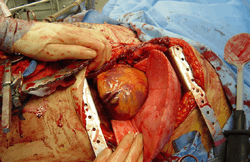Thoracotomy
| Thoracotomy | |
|---|---|
| Intervention | |
 | |
| ICD-9-CM | 34.02 |
| MeSH | D013908 |
A thoracotomy is an incision into the pleural space of the chest.[1] It is performed by surgeons (or emergency physicians under certain circumstances) to gain access to the thoracic organs, most commonly the heart, the lungs, or the esophagus, or for access to the thoracic aorta or the anterior spine (the latter may be necessary to access tumors in the spine).
Thoracotomy is a major surgical maneuver—it is the first step in many thoracic surgeries including lobectomy or pneumonectomy for lung cancer—and as such requires general anesthesia with endotracheal tube insertion and mechanical ventilation.
Thoracotomies are thought to be one of the most difficult surgical incisions to deal with post-operatively, because they are extremely painful and the pain can prevent the patient from breathing effectively, leading to atelectasis or pneumonia.
Approaches
There are many different approaches to thoracotomy. The most common modalities of thoracotomy follow.
Median sternotomy provides wide access to the mediastinum and is the incision of choice for most open-heart surgery and access to the anterior mediastinum.
Posterolateral thoracotomy is an incision through an intercostal space on the back, and is often widened with rib spreaders. It is a very common approach for operations on the lung or posterior mediastinum, including the esophagus. When performed over the fifth intercostal space, it allows optimal access to the pulmonary hilum (pulmonary artery and pulmonary vein) and therefore is considered the approach of choice for pulmonary resection (pneumonectomy and lobectomy).
Anterolateral thoracotomy is performed upon the anterior chest wall; left anterolateral thoracotomy is the incision of choice for open chest massage, a critical maneuver in the management of traumatic cardiac arrest. Anterolateral thoracotomy, like most surgical incisions, requires the use of tissue retractors—in this case, a "rib spreader" such as the Tuffier retractor.
Bilateral anterolateral thoracotomy combined with transverse sternotomy results in the "clamshell" incision, the largest incision commonly used in thoracic surgery.
The Ashrafian or Aztec thoracotomy was devised to give rapid access to the heart and pericardium through an incision that consists of an anterior thoracic incision followed in a vertical direction along the costo-chondral (rib-cartilage) junction.[2]
Upon completion of the surgical procedure, the chest is closed. One or more chest tubes—with one end inside the opened pleural cavity and the other submerged under saline solution inside a sealed container, forming an airtight drainage system—are necessary to remove air and fluid from the pleural cavity, preventing the development of pneumothorax or hemothorax.
Complications
In addition to pneumothorax, complications from thoracotomy include air leaks, infection, bleeding and respiratory failure. Postoperative pain is universal and intense, generally requiring opioids, and does interfere with the recovery of respiratory function. Paraplegia complicating thoracotomy is rare but catastrophic.[3][4]
In nearly all cases a chest tube, or more than one chest tube is placed. These tubes are used to drain air and fluid until the patient heals enough to take them out (usually a few days). Complications such as pneumothorax, tension pneumothorax, or subcutaneous emphysema can occur if these chest tubes become clogged. Furthermore, complications such as pleural effusion or hemothorax can occur if the chest tubes fail to drain the fluid around the lung in the pleural space after a thoracotomy. Clinicians should be on the look out for chest tube clogging as these tubes have a tendency to become occluded with fibrinous material or clot in the post operative period, and when this happens, complications ensue.
In the long term post operatively chronic pain can develop known as thoracotomy pain syndrome, this can last from a few years to a lifetime of continued pain and discomfort. Treatment to aid pain relief for this condition includes intra thoracic nerve blocks/opiates and epidurals although results vary from person to person and are dependent on numerous factors.
VATS
Video-assisted thoracoscopic surgery (VATS) is a less invasive alternative to thoracotomy in selected cases, much like laparoscopic surgery. Like laparoscopic surgery, its applications are rapidly expanding. Robotic surgery is a new but rapidly growing alternative that uses advanced technology with proven advantages.
References
- ↑ "thoracotomy" at Dorland's Medical Dictionary
- ↑ Ashrafian, H.; Athanasiou, T. (2010). "Emergency prehospital on-scene thoracotomy: A novel method". Collegium antropologicum 34 (4): 1449–1452. PMID 21874737.
- ↑ Attar, S.; Hankins, J. R.; Turney, S. Z.; Krasna, M. J.; McLaughlin, J. S. (1995). "Paraplegia after thoracotomy: Report of five cases and review of the literature". The Annals of thoracic surgery 59 (6): 1410–1415; discussion 1415–6. doi:10.1016/0003-4975(95)00196-R. PMID 7771819.
- ↑ Brodbelt, A. R.; Miles, J. B.; Foy, P. M.; Broome, J. C. (2002). "Intraspinal oxidised cellulose (Surgicel) causing delayed paraplegia after thoracotomy--a report of three cases". Annals of the Royal College of Surgeons of England 84 (2): 97–99. PMC 2503802. PMID 11995773.
| ||||||||||||||||||||||||||||||||||
| ||||||||||||||||||||||||||||||||||||||||||||||||||||||||||||||||||||||||||||||||||||||||||||||||||||||||||||||||||||||||||||||||||||||||||